2015 YAMAHA FZS SVHO engine oil
[x] Cancel search: engine oilPage 5 of 106

Table of contents
General and important labels ........... 1Identification numbers .................... 1
Primary Identification (PRI-ID)
number............................................ 1
Craft Identification Number (CIN) ....... 1
Engine serial number.......................... 1
Manufactured date label .................... 2
Model information ........................... 2
Builder’s plate .................................... 2
Important labels .............................. 4
Warning labels.................................... 5
Other labels ........................................ 9
Safety information ........................... 11 Limitations on who may operate the watercraft ............................. 11
Cruising limitations ........................ 12
Operation requirements ................ 13
Recommended equipment ........... 15
Hazard information........................ 16
Watercraft characteristics ............. 16
Wakeboarding and water-skiing ... 18
Safe boating rules ......................... 19
Enjoy your watercraft responsibly ................................. 20
Description....................................... 21 Watercraft glossary ....................... 21
Location of main components ...... 22
Control function operation ............. 26 Watercraft control functions ......... 26
Remote control transmitter .............. 26
Yamaha Security System ................. 27
Engine stop switch .......................... 28
Engine shut-off switch .................... 28
Start switch ..................................... 28
Throttle lever .................................... 29
Steering system ............................... 29
Telescopic steering system.............. 30
Cooling water pilot outlets ............... 30
Water separator................................ 31
Watercraft operation ...................... 32Watercraft operation functions ..... 32
Reverse system ................................ 32
Quick Shift Trim System
(Q.S.T.S.) ....................................... 32
Watercraft operation modes ......... 34
Low RPM Mode ............................... 34
Instrument operation ...................... 36Dual analog meter unit.................. 36
Speedometer.................................... 36
Tachometer ...................................... 36
Information display ........................... 37
Equipment operation ...................... 41Equipment..................................... 41
Seats ................................................ 41
Handgrips ......................................... 42
Reboarding grip................................ 42
Reboarding step ............................... 42
Bow eye............................................ 43
Stern eyes ........................................ 43
Cleat ................................................. 43
Storage compartments .................... 44
Fire extinguisher holder and cover ... 47
Operation and handling
requirements ................................... 49Fuel requirements ......................... 49
Fuel................................................... 49
Engine oil requirements ................ 51
Engine oil .......................................... 51
Draining the bilge water ................ 52
Draining the bilge water on land....... 52
Draining the bilge water on water .... 53
Transporting on a trailer................ 54
First-time operation ........................ 55 Engine break-in............................. 55
Pre-operation checks ..................... 56
Pre-operation checklist .................... 56
UF3K71E0.book Page 1 Monday, August 18, 2014 2:54 PM
Page 6 of 106

Table of contents
Pre-operation check points........... 58
Pre-launch checks ........................... 58
Post-launch checks ......................... 65
Operation ......................................... 67Operating your watercraft ............. 67
Getting to know your watercraft ...... 67
Learning to operate your
watercraft ...................................... 67
Riding position ................................. 68
Launching the watercraft ................. 68
Starting the engine on water ............ 68
Stopping the engine ......................... 69
Leaving the watercraft...................... 69
Operating the watercraft .................. 69
Turning the watercraft ...................... 70
Stopping the watercraft ................... 71
Operating the watercraft in reverse .......................................... 72
Boarding the watercraft ................... 72
Starting off........................................ 75
Capsized watercraft ......................... 76
Beaching and docking the watercraft ...................................... 77
Operating in weeded areas .............. 78
After removing the watercraft from the water ....................................... 78
Care and storage............................. 79Post-operation care ...................... 79
Flushing the cooling water
passages....................................... 79
Cleaning the watercraft .................... 80
Battery care ...................................... 80
Long-term storage ........................ 83
Cleaning ........................................... 83
Lubrication ....................................... 83
Rustproofing..................................... 83
Maintenance .................................... 85 Maintenance.................................. 85
Tool kit.............................................. 85
Removing and installing the engine
cover ............................................. 85 Periodic maintenance chart ............. 87
Engine oil and oil filter ...................... 89
Specifications .................................. 90
Specifications ............................... 90
Trouble recovery ............................. 91 Troubleshooting ............................ 91
Troubleshooting chart ...................... 91
Emergency procedures ................ 94
Cleaning the jet intake and
impeller ......................................... 94
Jumping the battery ......................... 95
Replacing the fuses .......................... 95
Towing the watercraft....................... 97
Submerged watercraft ..................... 97
Index................................................. 98
UF3K71E0.book Page 2 Monday, August 18, 2014 2:54 PM
Page 26 of 106
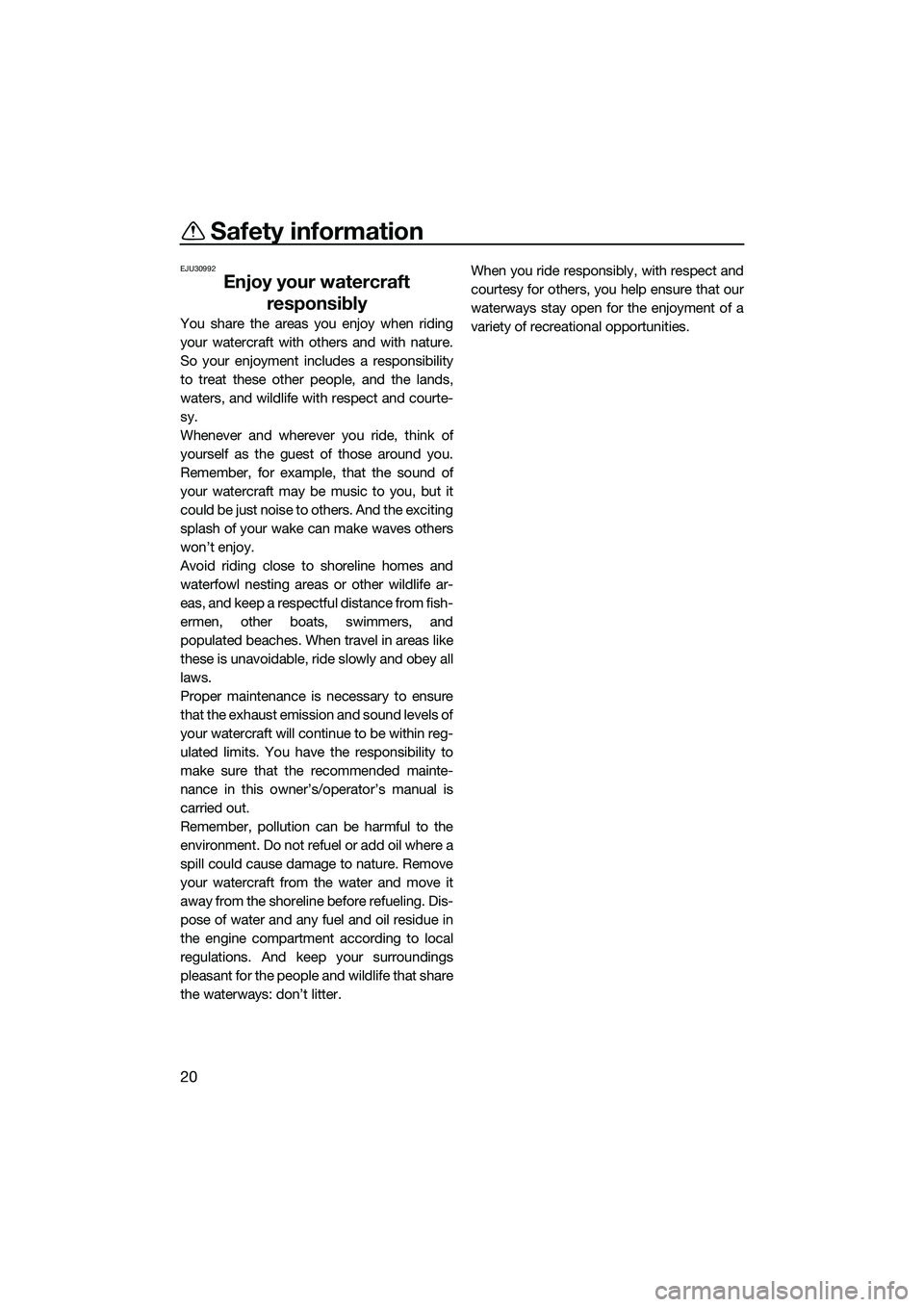
Safety information
20
EJU30992
Enjoy your watercraft responsibly
You share the areas you enjoy when riding
your watercraft with others and with nature.
So your enjoyment includes a responsibility
to treat these other people, and the lands,
waters, and wildlife with respect and courte-
sy.
Whenever and wherever you ride, think of
yourself as the guest of those around you.
Remember, for example, that the sound of
your watercraft may be music to you, but it
could be just noise to others. And the exciting
splash of your wake can make waves others
won’t enjoy.
Avoid riding close to shoreline homes and
waterfowl nesting areas or other wildlife ar-
eas, and keep a respectful distance from fish-
ermen, other boats, swimmers, and
populated beaches. When travel in areas like
these is unavoidable, ride slowly and obey all
laws.
Proper maintenance is necessary to ensure
that the exhaust emission and sound levels of
your watercraft will continue to be within reg-
ulated limits. You have the responsibility to
make sure that the recommended mainte-
nance in this owner’s/operator’s manual is
carried out.
Remember, pollution can be harmful to the
environment. Do not refuel or add oil where a
spill could cause damage to nature. Remove
your watercraft from the water and move it
away from the shoreline before refueling. Dis-
pose of water and any fuel and oil residue in
the engine compartment according to local
regulations. And keep your surroundings
pleasant for the people and wildlife that share
the waterways: don’t litter. When you ride responsibly, with respect and
courtesy for others, you help ensure that our
waterways stay open for the enjoyment of a
variety of recreational opportunities.
UF3K71E0.book Page 20 Monday, August 18, 2014 2:54 PM
Page 31 of 106

Description
25
Engine compartment
12
3
4 6
5
10 11
8
97
1 Engine cover
2 Air filter case
3 Water separator (page 31)
4 Fuel tank
5 Battery (page 59)
6 Flushing hose connector
7 Watertight storage compartment
8 Spark plug/Spark plug cap/Ignition coil
9 Electrical box
10 Engine oil filler cap (page 51) 11
Dipstick
UF3K71E0.book Page 25 Monday, August 18, 2014 2:54 PM
Page 43 of 106
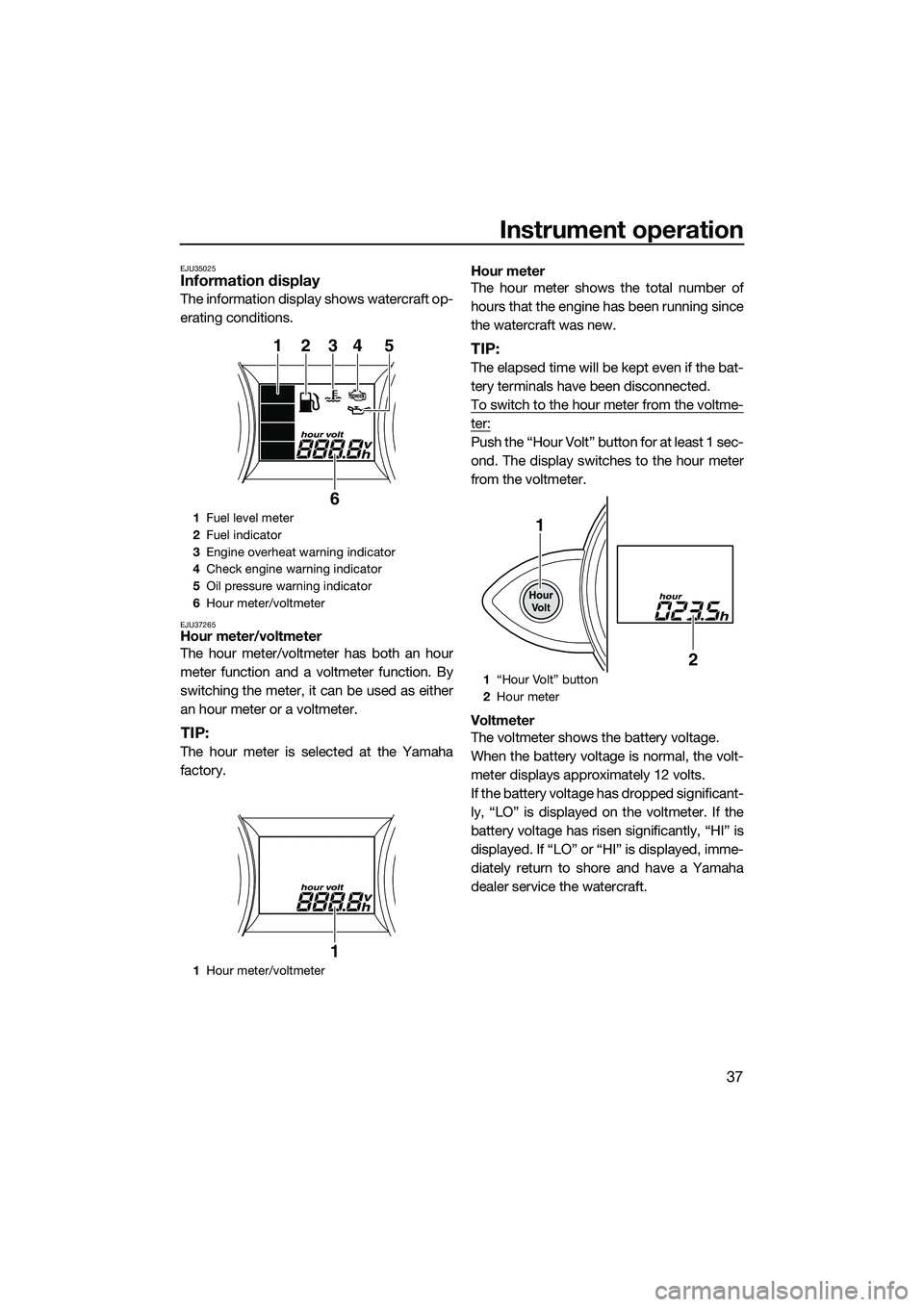
Instrument operation
37
EJU35025Information display
The information display shows watercraft op-
erating conditions.
EJU37265Hour meter/voltmeter
The hour meter/voltmeter has both an hour
meter function and a voltmeter function. By
switching the meter, it can be used as either
an hour meter or a voltmeter.
TIP:
The hour meter is selected at the Yamaha
factory.Hour meter
The hour meter shows the total number of
hours that the engine has been running since
the watercraft was new.
TIP:
The elapsed time will be kept even if the bat-
tery terminals have been disconnected.
To switch to the hour meter from the voltme-
ter:
Push the “Hour Volt” button for at least 1 sec-
ond. The display switches to the hour meter
from the voltmeter.
Voltmeter
The voltmeter shows the battery voltage.
When the battery voltage is normal, the volt-
meter displays approximately 12 volts.
If the battery voltage has dropped significant-
ly, “LO” is displayed on the voltmeter. If the
battery voltage has risen significantly, “HI” is
displayed. If “LO” or “HI” is displayed, imme-
diately return to shore and have a Yamaha
dealer service the watercraft.
1
Fuel level meter
2 Fuel indicator
3 Engine overheat warning indicator
4 Check engine warning indicator
5 Oil pressure warning indicator
6 Hour meter/voltmeter
1 Hour meter/voltmeter
12345
6
1
1 “Hour Volt” button
2 Hour meter
1
2
UF3K71E0.book Page 37 Monday, August 18, 2014 2:54 PM
Page 44 of 106
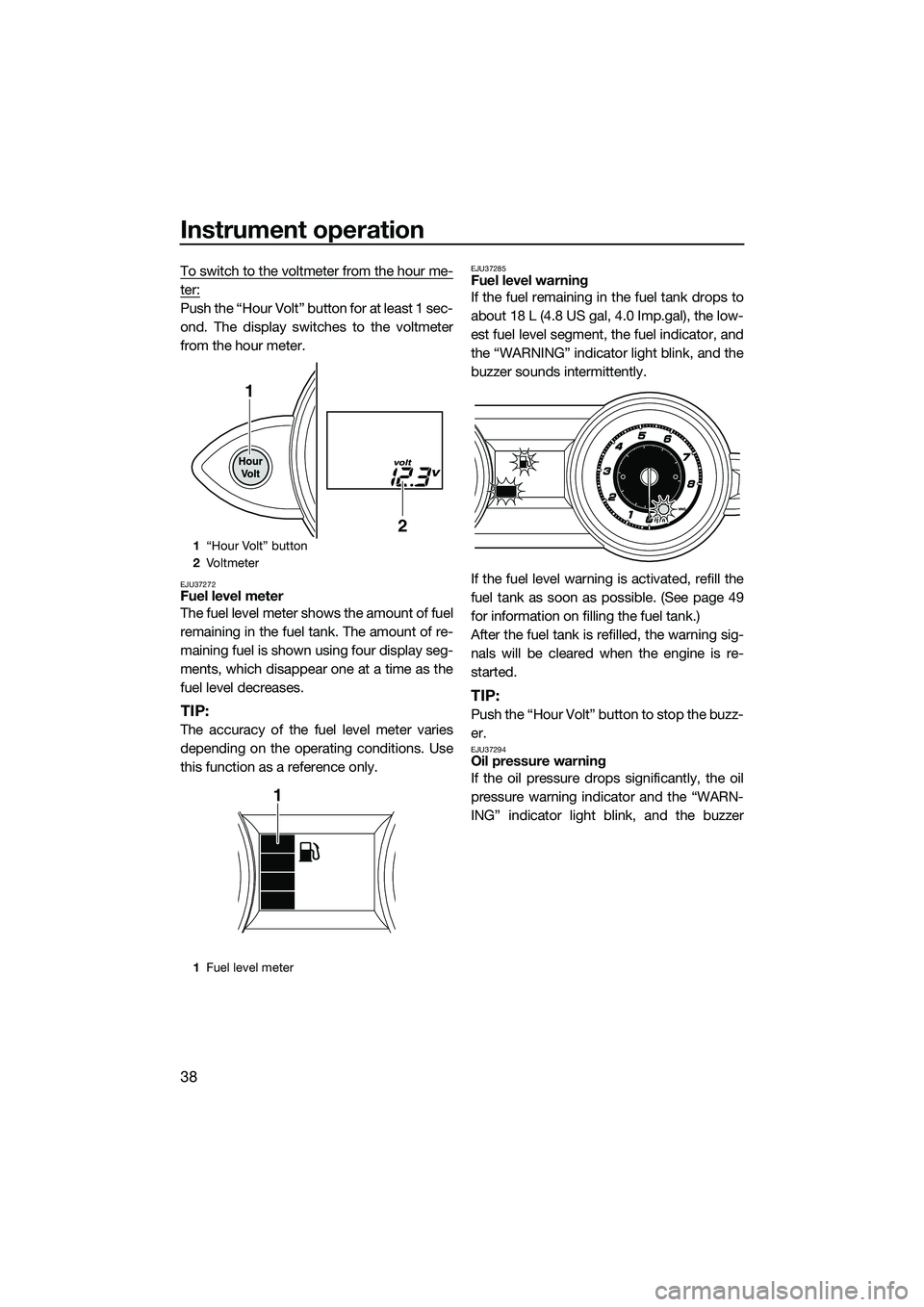
Instrument operation
38
To switch to the voltmeter from the hour me-
ter:
Push the “Hour Volt” button for at least 1 sec-
ond. The display switches to the voltmeter
from the hour meter.
EJU37272Fuel level meter
The fuel level meter shows the amount of fuel
remaining in the fuel tank. The amount of re-
maining fuel is shown using four display seg-
ments, which disappear one at a time as the
fuel level decreases.
TIP:
The accuracy of the fuel level meter varies
depending on the operating conditions. Use
this function as a reference only.
EJU37285Fuel level warning
If the fuel remaining in the fuel tank drops to
about 18 L (4.8 US gal, 4.0 Imp.gal), the low-
est fuel level segment, the fuel indicator, and
the “WARNING” indicator light blink, and the
buzzer sounds intermittently.
If the fuel level warning is activated, refill the
fuel tank as soon as possible. (See page 49
for information on filling the fuel tank.)
After the fuel tank is refilled, the warning sig-
nals will be cleared when the engine is re-
started.
TIP:
Push the “Hour Volt” button to stop the buzz-
er.
EJU37294Oil pressure warning
If the oil pressure drops significantly, the oil
pressure warning indicator and the “WARN-
ING” indicator light blink, and the buzzer
1“Hour Volt” button
2 Vo l t m et e r
1 Fuel level meter
1
2
1
UF3K71E0.book Page 38 Monday, August 18, 2014 2:54 PM
Page 45 of 106
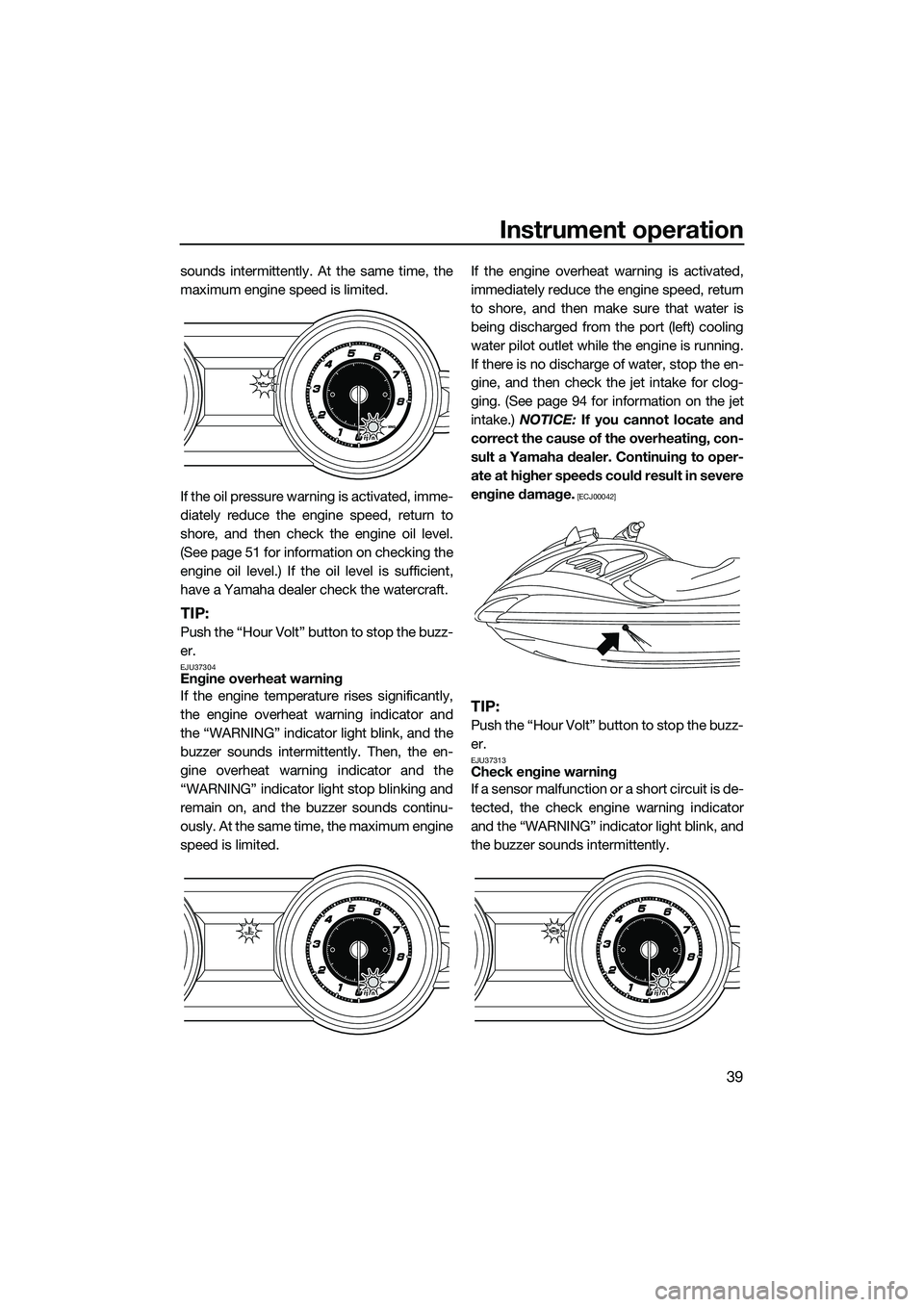
Instrument operation
39
sounds intermittently. At the same time, the
maximum engine speed is limited.
If the oil pressure warning is activated, imme-
diately reduce the engine speed, return to
shore, and then check the engine oil level.
(See page 51 for information on checking the
engine oil level.) If the oil level is sufficient,
have a Yamaha dealer check the watercraft.
TIP:
Push the “Hour Volt” button to stop the buzz-
er.
EJU37304Engine overheat warning
If the engine temperature rises significantly,
the engine overheat warning indicator and
the “WARNING” indicator light blink, and the
buzzer sounds intermittently. Then, the en-
gine overheat warning indicator and the
“WARNING” indicator light stop blinking and
remain on, and the buzzer sounds continu-
ously. At the same time, the maximum engine
speed is limited.If the engine overheat warning is activated,
immediately reduce the engine speed, return
to shore, and then make sure that water is
being discharged from the port (left) cooling
water pilot outlet while the engine is running.
If there is no discharge of water, stop the en-
gine, and then check the jet intake for clog-
ging. (See page 94 for information on the jet
intake.)
NOTICE: If you cannot locate and
correct the cause of the overheating, con-
sult a Yamaha dealer. Continuing to oper-
ate at higher speeds could result in severe
engine damage.
[ECJ00042]
TIP:
Push the “Hour Volt” button to stop the buzz-
er.
EJU37313Check engine warning
If a sensor malfunction or a short circuit is de-
tected, the check engine warning indicator
and the “WARNING” indicator light blink, and
the buzzer sounds intermittently.
UF3K71E0.book Page 39 Monday, August 18, 2014 2:54 PM
Page 57 of 106
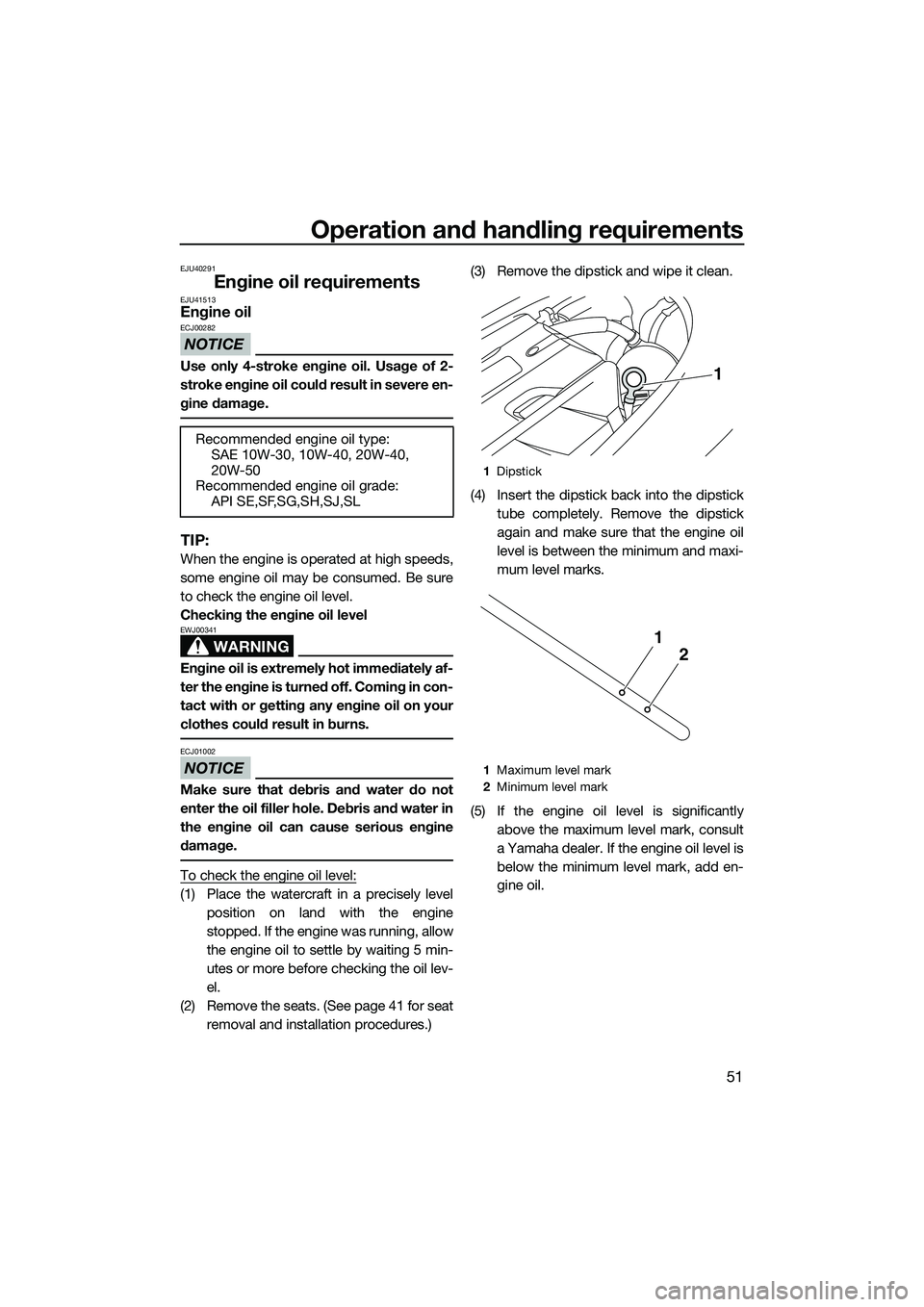
Operation and handling requirements
51
EJU40291
Engine oil requirementsEJU41513Engine oil
NOTICE
ECJ00282
Use only 4-stroke engine oil. Usage of 2-
stroke engine oil could result in severe en-
gine damage.
TIP:
When the engine is operated at high speeds,
some engine oil may be consumed. Be sure
to check the engine oil level.
Checking the engine oil level
WARNING
EWJ00341
Engine oil is extremely hot immediately af-
ter the engine is turned off. Coming in con-
tact with or getting any engine oil on your
clothes could result in burns.
NOTICE
ECJ01002
Make sure that debris and water do not
enter the oil filler hole. Debris and water in
the engine oil can cause serious engine
damage.
To check the engine oil level:
(1) Place the watercraft in a precisely levelposition on land with the engine
stopped. If the engine was running, allow
the engine oil to settle by waiting 5 min-
utes or more before checking the oil lev-
el.
(2) Remove the seats. (See page 41 for seat removal and installation procedures.) (3) Remove the dipstick and wipe it clean.
(4) Insert the dipstick
back into the dipstick
tube completely. Remove the dipstick
again and make sure that the engine oil
level is between the minimum and maxi-
mum level marks.
(5) If the engine oil level is significantly above the maximum level mark, consult
a Yamaha dealer. If the engine oil level is
below the minimum level mark, add en-
gine oil.
Recommended engine oil type:
SAE 10W-30, 10W-40, 20W-40,
20W-50
Recommended engine oil grade: API SE,SF,SG,SH,SJ,SL
1Dipstick
1 Maximum level mark
2 Minimum level mark
1
2
1
UF3K71E0.book Page 51 Monday, August 18, 2014 2:54 PM